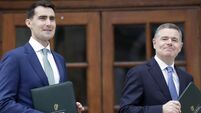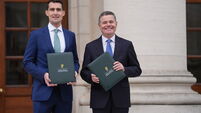Euro-zone business activity at 15-month high despite tariffs

Shoppers in a retail street in Frankfurt, Germany, on Friday, Dec. 30, 2022. European stocks were on track to cap their worst annual performance since 2018, triggered by a slowing economy over the war in Ukraine and aggressive central bank tightening.
The euro area’s private sector grew at the quickest pace in 15 months as manufacturing exited a three-year downturn despite a deal locking in higher levies for exports to the US.
The Composite Purchasing Managers’ Index compiled by S&P Global rose to 51.1 in August from 50.9 in July, further above the 50 threshold separating expansion from contraction. Analysts had predicted a reading of 50.6.
While services weakened a little, in line with estimates, manufacturing saw a jump to 50.5, bucking expectations for a slight slowdown and recording its first expansion since June 2022. Germany’s factory sector also neared the end of a three-year slump.
“Things are getting better,” Cyrus de la Rubia, an economist at Hamburg Commercial Bank, said Thursday in a statement. “Despite headwinds like US tariffs and general uncertainty, businesses across the euro zone seem to be coping reasonably well.” The euro was steady against the dollar at $1.1654 after erasing small losses earlier, while euro area bonds held declines with the German 10-year yield two basis points higher at 2.73%.
The data provide more evidence of Europe’s resilience to obstacles ranging from trade to wars, and will support those European Central Bank officials who say there’s no rush into lowering interest rates further.
President Christine Lagarde said Wednesday that the 15% US levy on most goods from the European Union, which kicked in this month, is a touch above the level the ECB assumed in its June projections but “well below” a more severe scenario it had also mapped out.
Even so, the pact with President Donald Trump’s administration looks like it will crimp business in the months ahead, according to de la Rubia, who highlighted a second straight decline in foreign orders for euro-zone manufacturers.
“US trade policy is leaving its mark,” he said. “Germany had been holding up well, possibly due to pre-emptive purchases from the U.S., but now it’s also seeing a drop in orders. France has climbed out of the deep hole of falling foreign demand over the last months, but incoming orders are still on the decline.” Germany’s economy will probably stagnate in the third quarter after a slight contraction in the second, the Bundesbank said Thursday in its monthly report. While the US trade deal eased uncertainty, it remains high given unanswered questions and the “volatile US economic policy,” it said, without excluding a small gain in output over 2025 as a whole.
The euro zone’s 20-nation economy unexpectedly eked out growth of 0.1% between April and June, though this was significantly lower than the 0.6% expansion in the previous three months, which was driven by tariff-related front-loading. Inflation is hovering around the ECB’s 2% target.
Officials in Frankfurt are widely expected to leave the key deposit rate at 2% when they reconvene after their summer break in September, extending a pause that began last month following a yearlong campaign of cuts.
PMIs are closely watched by markets as they arrive early in the month and are good at revealing trends and turning points in an economy. A measure of breadth of changes in output rather than depth, business surveys can sometimes be difficult to map directly to quarterly GDP.
A PMI reading from the UK came in far ahead of expectations, at 53, while the US composite number, due later Thursday, is also estimated to have remained well over 50.
Bloomberg











